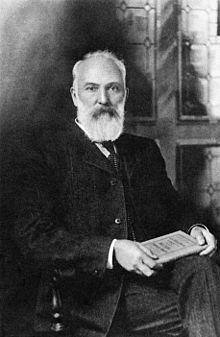Theodore Lukens
| Theodore Parker Lukens | |
|---|---|

Lukens c. 1890
|
|
| 4th Mayor of Pasadena | |
|
In office May 1890 – May 1892 |
|
| Preceded by | Amos G. Throop |
| Succeeded by | Oscar F. Weed |
| 6th Mayor of Pasadena | |
|
In office May 1894 – December 1895 |
|
| Preceded by | Oscar F. Weed |
| Succeeded by | John S. Cox |
| Personal details | |
| Born |
October 6, 1848 Currently,New Concord, Ohio |
| Died | July 1, 1918 (aged 69) Pasadena, California |
| Political party | Republican |
| Spouse(s) | Charlotte Dyer (1871 - 1905), H. Sibyl Swett (1906 - 1918) |
| Children | Helen Lukens Gaut (m. Feb.19, 1906 - James H. Gaut) |
| Parents | William E. Lukens, Margaret Cooper |
| Profession | Forester, conservationist |
| Religion | Christian Science |
October 6, 1848
Theodore Parker Lukens (October 6, 1848 – July 1, 1918) was an American conservationist, real estate investor, civic leader, and forester who believed that burned over mountains could again be covered in timber which would protect watersheds. Lukens collected pine cones and seeds of different types and conducted experimental plantings on the mountain slopes above Pasadena, California. His perseverance earned him the name "Father of Forestry."
Lukens established Henninger Flats tree nursery, which provided seed stock for an estimated 70,000 trees. He worked for the United States Forest Service and was acting supervisor of the San Gabriel Timberland Reserve and the San Bernardino Forest Reserve in 1906.
Lukens served two terms as mayor of Pasadena and was active in municipal and civic affairs of early-day Pasadena. Lukens remained prominent in civic and conservation issues until his death in 1918.
Lukens was interested in growing plants, even before moving out to Southern California from Illinois, where he had owned and operated a nursery in Whiteside County, Illinois. By 1882 the Lukens family established a home in Pasadena. Lukens already knew of the hardwoods in his native Midwest but now the former nurseryman sought to learn about the native and non-native trees of Southern California. Among them: live oak, pepper, camphor, umbrella, eucalyptus and various citrus trees.
Lukens undertook several expeditions to study the San Gabriel and San Bernardino Mountains from 1897 to 1899. He learned the "paradise" of Southern California had some serious problems as well. The increased use and misuse of resources by miners, loggers and owners had devastated the lands. Wildfires caused the worst damage due to the Mediterranean climate of long, hot and dry summers which turned fires into infernos, leaving behind burned and bare hillsides, resulting in erosion and flooding during the rainy season.
...
Wikipedia
